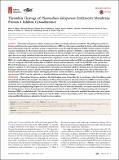| dc.contributor.author | Gillrie, Mark R. | en_US |
| dc.contributor.author | Renaux, Bernard | en_US |
| dc.contributor.author | Russell-Goldman, Eleanor | en_US |
| dc.contributor.author | Avril, Marion | en_US |
| dc.contributor.author | Brazier, Andrew J. | en_US |
| dc.contributor.author | Mihara, Koichiro | en_US |
| dc.contributor.author | Di Cera, Enrico | en_US |
| dc.contributor.author | Milner, Danny A. | en_US |
| dc.contributor.author | Hollenberg, Morley D. | en_US |
| dc.contributor.author | Smith, Joseph D. | en_US |
| dc.contributor.author | Ho, May | en_US |
| dc.date.accessioned | 2016-11-18T20:08:11Z | |
| dc.date.issued | 2016 | en_US |
| dc.identifier.citation | Gillrie, M. R., B. Renaux, E. Russell-Goldman, M. Avril, A. J. Brazier, K. Mihara, E. Di Cera, et al. 2016. “Thrombin Cleavage of Plasmodium falciparum Erythrocyte Membrane Protein 1 Inhibits Cytoadherence.” mBio 7 (5): e01120-16. doi:10.1128/mBio.01120-16. http://dx.doi.org/10.1128/mBio.01120-16. | en |
| dc.identifier.issn | 2150-7511 | en |
| dc.identifier.uri | http://nrs.harvard.edu/urn-3:HUL.InstRepos:29407896 | |
| dc.description.abstract | ABSTRACT Plasmodium falciparum malaria remains one of the most deadly infections worldwide. The pathogenesis of the infection results from the sequestration of infected erythrocytes (IRBC) in vital organs, including the brain, with resulting impairment of blood flow, hypoxia, and lactic acidosis. Sequestration occurs through the adhesion of IRBC to host receptors on microvascular endothelium by Plasmodium falciparum erythrocyte membrane protein 1 (PfEMP1), a large family of variant surface antigens, each with up to seven extracellular domains that can bind to multiple host receptors. Consequently, antiadhesive therapies directed at single endothelial adhesion molecules may not be effective. In this study, we demonstrated that the serine protease thrombin, which is pivotal in the activation of the coagulation cascade, cleaved the major parasite adhesin on the surface of IRBC. As a result, adhesion under flow was dramatically reduced, and already adherent IRBC were detached. Thrombin cleavage sites were mapped to the Duffy binding-like δ1 (DBLδ1) domain and interdomains 1 and 2 in the PfEMP1 of the parasite line IT4var19. Furthermore, we observed an inverse correlation between the presence of thrombin and IRBC in cerebral malaria autopsies of children. We investigated a modified (R67A) thrombin and thrombin inhibitor, hirugen, both of which inhibit the binding of substrates to exosite I, thereby reducing its proinflammatory properties. Both approaches reduced the barrier dysfunction induced by thrombin without affecting its proteolytic activity on PfEMP1, raising the possibility that thrombin cleavage of variant PfEMP1 may be exploited as a broadly inhibitory antiadhesive therapy. | en |
| dc.language.iso | en_US | en |
| dc.publisher | American Society for Microbiology | en |
| dc.relation.isversionof | doi:10.1128/mBio.01120-16 | en |
| dc.relation.hasversion | http://www.ncbi.nlm.nih.gov/pmc/articles/PMC5021802/pdf/ | en |
| dash.license | LAA | en_US |
| dc.title | Thrombin Cleavage of Plasmodium falciparum Erythrocyte Membrane Protein 1 Inhibits Cytoadherence | en |
| dc.type | Journal Article | en_US |
| dc.description.version | Version of Record | en |
| dc.relation.journal | mBio | en |
| dash.depositing.author | Russell-Goldman, Eleanor | en_US |
| dc.date.available | 2016-11-18T20:08:11Z | |
| dc.identifier.doi | 10.1128/mBio.01120-16 | * |
| dash.authorsordered | false | |
| dash.contributor.affiliated | Russell-Goldman, Eleanor | |
| dash.contributor.affiliated | Milner, Danny | |


